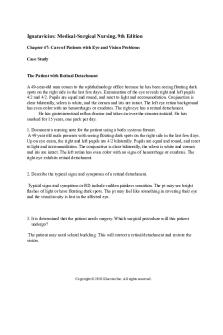Med Surg 2 Case Study #6 Chap 47 PDF

| Title | Med Surg 2 Case Study #6 Chap 47 |
|---|---|
| Course | Medical Surgical |
| Institution | Capscare Academy for Health Care Education |
| Pages | 4 |
| File Size | 76.9 KB |
| File Type | |
| Total Downloads | 50 |
| Total Views | 147 |
Summary
Med Surg 2...
Description
OluwaBusayo (Busayo) Ojo Med Surg 2 Case Study #6 6/13/2020
Case Study, Chapter 47, Management of Patients With Gastric and Duodenal Disorders
1. Crystal Monte, 32 years of age, is a female patient who is admitted to the medical-surgical unit after a laparoscopic Roux-en-Y gastric bypass for weight loss. Prior to choosing the surgery, the patient tried numerous diets and exercise programs without success and developed metabolic syndrome that led to insulin resistance. The patient’s parents both had complications related to morbid obesity and diabetes, so the patient wanted to have successful long-term weight loss and to decrease the risk factors for developing diabetes. The patient met with the multidisciplinary team before surgery, which consisted of a social worker, nurse counselor, dietitian, psychologist, exercise therapist, and surgeon. The patient received intensive preoperative teaching and followed the diet she would follow after surgery for several weeks before the operation. (Learning Objective 5) a. What nursing management should be provided for the patient postoperatively? Ans:
Assess vital signs every 4 hours and call the surgeon with abnormal parameters as detailed in the clinical pathway for the hospital.
Assess airway for patency and observe use of an incentive spirometer, splinting and coughing every hour while awake.
Assess oxygen saturation according to clinical pathway parameters and provide oxygen as ordered and report adventitious lung sounds or change in the color of the sputum.
Provide pain management, usually patient-controlled analgesia. Assess respirations, pulse oximetry, and level of pain and level of sedation.
Position in high Fowler’s to decrease discomfort and promote gastric emptying.
Administer antiemetics for nausea since NG tubes are contraindicated.
Assess fluid volume status via intake and output and assess for signs of dehydration, including dry mucous membranes, increased thirst, or concentrated urine. Provide IV fluids as ordered until the patient is able to take sufficient oral intake and the surgeon has collaborated to discontinue the fluids.
Assess bowel sounds every 4 hours and as needed. Once the bowel sounds have returned provide oral intake per orders. Sugar-free liquids are preferred since they are not associated with the dumping syndrome.
Advance the diet per orders with six small feedings consisting of 600 to 800 calories each day. Consult with the dietician to provide nutrition and patient education.
Instruct the patient on the dumping syndrome and to avoid consuming simple sugars because it will result in a quick dump into the intestine and subsequent abdominal cramping, nausea, and diarrhea.
Provide antibiotics postoperatively, as ordered, to help decrease risk for infection.
Provide deep vein thrombosis (DVT) prophylaxis, per orders, including heparin or Lovenox subcutaneous, pneumatic compression boots, antithromboembolism stockings, and leg exercises. Early ambulation begins the first postoperative day with a short walk with assistance and sitting up in the bedside chair.
Assess surgical dressing and JP drain for drainage and report hemorrhage or signs of hypovolemic shock (hypotension, tachycardia, tachypnea) to the surgeon and take appropriate emergent actions.
Monitor ordered lab results and report any abnormal results promptly to the surgeon and receive orders
b. What discharge instructions should the nurse provide the patient? Ans: The nurse should instruct the patient on the following and provide written instructions to the patient: o Provide detailed diet instructions. Report to the surgeon increased thirst, dry mucous membranes, and dark concentrated urine, and report nausea and vomiting or diarrhea.
o Instruct on potential nutritional deficiencies and vitamin and mineral supplements ordered. The surgeon may instruct the patient to take a children’s chewable multivitamin twice a day. The surgeon may have asked the patient to take the vitamin before surgery and continue it after. The patient may also be ordered to take a liquid nutritional supplement to ensure that the patient receives enough daily protein. o Report to the surgeon elevated temperature greater than 101°F; productive cough with colored sputum; redness, swelling, and purulent drainage at the incision site; or burning upon urination and frequent urination. o Inspect the incision daily. Report to the surgeon any redness, edema, or drainage. o Instruct on emptying JP and recording output. o Review pain medication. o Review activity restrictions. o Review follow-up with the surgeon. o Refer to support group
2. Ms. George is a 32-year-old computer programmer. Over the last several months, she has had increased episodes of a burning sensation in the mid epigastrium and back. The pain subsides after eating. Based on her history, the physician orders an endoscopy that reveals several peptic ulcers. Treatment of the ulcers includes antibiotics, proton pump inhibitors, and bismuth salts. (Learning Objectives 1 and 3) a. Correlate Ms. George’s clinical presentation to the pathophysiology of peptic ulcers. Ans: Peptic ulcers develop primarily in the gastroduodenal mucosa because this tissue cannot withstand the digestive action of gastric acid and pepsin. The pain is believed to occur when the increased acid content of the stomach and duodenum erodes the lesion and stimulates the exposed nerve endings. Another theory suggests that contact of the lesion with the
acid stimulates a local reflex mechanism that initiates contractions of the adjacent smooth muscle. b. Ms. George asks why eating decreases her pain; how does the nurse respond? Ans: Pain is usually relieved by eating, because food neutralizes the acid. Pain is also relieved by taking alkali; however, once the stomach is emptied or the alkali’s effect has decreased, pain returns. c. Explain the rationale for the prescribed pharmacologic therapy. Ans: The combination of antibiotics, proton-pump inhibitors, and bismuth salts suppresses or eradicates H. pylori which is the cause of the peptic ulcer disease. The H. pylori may be acquired through ingestion of food and water, or through person-to-person contact and exposure to emesis. The proton pump inhibitors treat the hypersecretion of gastric acid that may be the etiology of peptic ulcer disease. The bismuth salts suppresses H. pylori bacteria in the gastric mucosa and assists with healing of mucosal ulcers....
Similar Free PDFs

Med Surg 2 Case Study #6 Chap 47
- 4 Pages

Med surg 1 case study renal
- 3 Pages

Med Surg 2 Final Study Guide
- 25 Pages
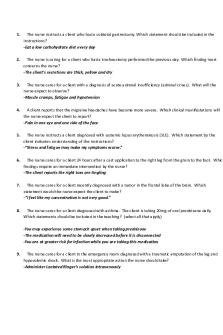
Kaplan med surg 2
- 8 Pages
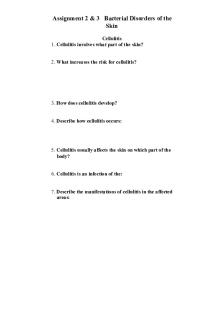
Med SURG; assignment 2
- 9 Pages
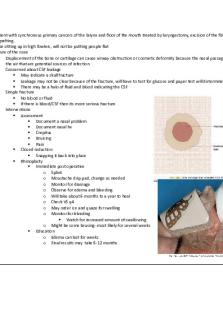
Med Surg II - Exam 2 Study Guide
- 57 Pages

Med Surg 2 Exam 3 Study Guide
- 22 Pages

Med-Surg Test #2 Study Guide
- 10 Pages

Med Surg 2 Study Guide Answer Key
- 145 Pages
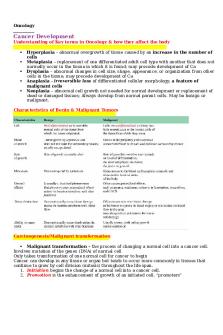
MED SURG 2 first study guide
- 20 Pages

Med Surg Study guide Notes
- 66 Pages

Chap 6-2 - answer case
- 2 Pages
Popular Institutions
- Tinajero National High School - Annex
- Politeknik Caltex Riau
- Yokohama City University
- SGT University
- University of Al-Qadisiyah
- Divine Word College of Vigan
- Techniek College Rotterdam
- Universidade de Santiago
- Universiti Teknologi MARA Cawangan Johor Kampus Pasir Gudang
- Poltekkes Kemenkes Yogyakarta
- Baguio City National High School
- Colegio san marcos
- preparatoria uno
- Centro de Bachillerato Tecnológico Industrial y de Servicios No. 107
- Dalian Maritime University
- Quang Trung Secondary School
- Colegio Tecnológico en Informática
- Corporación Regional de Educación Superior
- Grupo CEDVA
- Dar Al Uloom University
- Centro de Estudios Preuniversitarios de la Universidad Nacional de Ingeniería
- 上智大学
- Aakash International School, Nuna Majara
- San Felipe Neri Catholic School
- Kang Chiao International School - New Taipei City
- Misamis Occidental National High School
- Institución Educativa Escuela Normal Juan Ladrilleros
- Kolehiyo ng Pantukan
- Batanes State College
- Instituto Continental
- Sekolah Menengah Kejuruan Kesehatan Kaltara (Tarakan)
- Colegio de La Inmaculada Concepcion - Cebu


